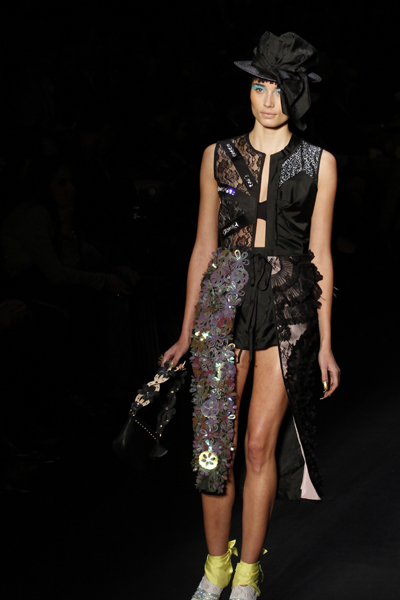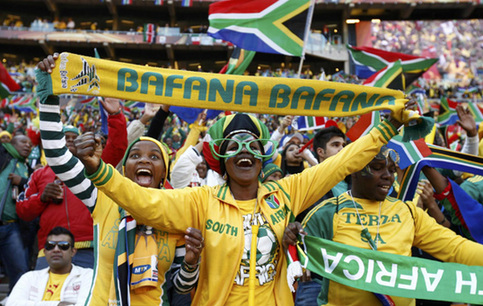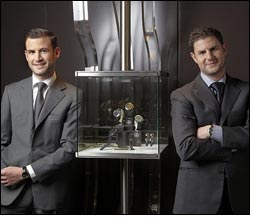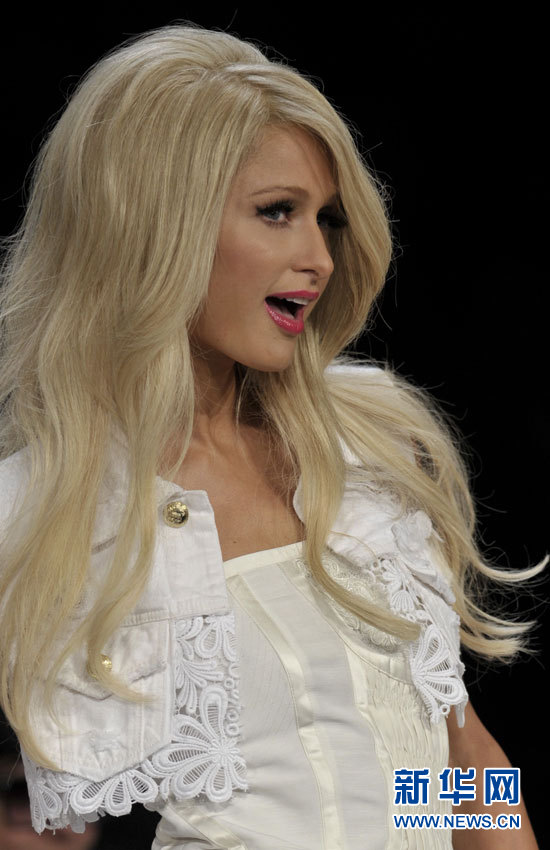 Lauren Peacher
Lauren Peacher Lola Mansil
Lola Mansil Martina M
Martina M Guiri Uribe
Guiri Uribe Austin Levine
Austin Levine
 Models present creations from Fause Haten's Summer 2010/11 collection during Sao Paulo Fashion Week June 11, 2010.
Models present creations from Fause Haten's Summer 2010/11 collection during Sao Paulo Fashion Week June 11, 2010.
There are limits to how far a luxury company can diversify its operations without diluting its brand or confusing consumers, luxury executives and experts said this week.
A jeweler might successfully launch a perfume but a handbag maker might not and it is easier for a jeweler to look credible producing watches than it is venturing into making handbags, they said.
Brands are sensitive, associated to values and emotions which are not suitable to every product.
Italian jeweler Bulgari (BULG.MI) is investing significantly into soft leather goods, hiring a high-profile designer, opening dedicated stores and launching an advertising campaign.
But many analysts are skeptical Bulgari's move into handbags will be successful.
"Diversification into new areas, which you do not really master, can be risky," Isabelle Ardon, head of Paris-based luxury fund SG Gestion told the summit this week.
But Bulgari Chief Executive Francesco Trapani said he believed the brand was strong enough for its diversification to succeed.
"We want leather goods to become a significant part of our business," he told the summit.
The Italian company is keen to build up its "soft luxury" business because it traditionally makes much bigger margins than "hard luxury" such as watches and jewelry.
But the luxury industry is full of examples of failed attempts to branch out.
German pen maker Montblanc, part of Richemont (CFR.VX), is widely cited as a brand whose fine jewelry venture took many by surprise as it is closely associated with men's accessories.
On the other hand, Louis Vuitton's move into high jewelry fits the brand's exclusive image, luxury experts have said. The same goes for Hermes who hired designer Pierre Hardy to produce a fine jewelry collection launched in April.
Hermes, (HRMS.PA) originally a saddle-maker, also started branching out more than a century ago, which gives it more legitimacy than others.
"Diversification is rarely a driver, more a potential benefit," said James Lawson, director of London-based luxury market research specialists Ledbury Research.
He said Hermes was a good example of a single brand that has maintained its premium focus within the sector and weathered the storm well.
Family-owned leather goods maker Longchamp, whose logo is a man on a racing horse, recently started selling raincoats and jackets in its boutiques.
But the venture is an experience for now, not a new strategic direction for the company, Longchamp Chief Executive Jean Cassegrain told the summit this week.
He said the company did not have any plans to go into anything else, such as perfume.
"We are trying to build the brand in a controlled and structured way," he said.
"We would not have anything to say about perfume. There are too many brands that stand for little now aside from their perfume."
Alain Crevet, head of French luxury pen and lighter maker ST Dupont (DPTP.PA), said the brand's failed venture into ready-to-wear plunged the company into loss and shutting it down was the first thing he did when he joined it four years ago.
"I'm really convinced that in luxury, you have to be inspired and understand your brand history, your brand roots and your brand DNA," he said.
Luxury goods' core products have been selling better during last year's downturn than peripheral ones, U.S. consultancy Bain & Co said.
"Consumers prefer to buy a brand's best known products rather than items outside their main brand heritage," Bain said.
Other executives acknowledged diversification helped promotion more than revenues.
"We have a small hotel business, but this is more a public relation machine," said Bulgari's Trapani, adding he was not looking to branch out into new areas.
Italian designers Dolce & Gabbana have teamed up with Bacardi's vermouth brand Martini to launch their first co-branded drink this month in a rare diversification move for the fashion duo.
Domenico Dolce and Stefano Gabbana have designed and tested the drink which will be unveiled during Milan's upcoming menswear fashion week, the fashion house said on Thursday.
"As a result of a joint commitment, this new co-branding project strengthens a partnership started more than 10 years ago," Dolce & Gabbana said in a statement.
Unlike many fashion groups which branched out into jewelry, tableware or hotels to tap a wider client base amid the global financial downturn, the fashion duo has been cautious over diversification.
The drink marks the debut of Dolce & Gabbana in the wines and spirits sector and is their second co-branded product after launching a mobile phone with Motorola five years ago.
As part of their partnership with Martini, the designers have opened bars at their stores in Milan and Shanghai and launched a menswear line.
Privately-owned Bermuda-based Bacardi, which owns the Martini vermouth brand, will produce and sell the drink.
Dolce & Gabbana celebrate the 20th anniversary of their menswear line on June 19-20 in Milan
The World Watch and Jewellery Show BASELWORLD has received the GACG Award 2010 in Paris from the Global Anti-Counterfeiting Group (GACG) for its endeavours in the fight against product piracy and for the protection of intellectual property.
As part of the World Day against Counterfeiting, the show manage¬ment of the BASELWORLD Watch and Jewellery Show yesterday received the GACG Award 2010, the so-called "Trophée de l'Authentique”, in Paris from the Global Anti-Counterfeiting Group (GACG).
This award was made especially in recognition of the endeavours of the BASELWORLD Panel, which, as an internal arbitration tribunal for the show, has been engaged in the protection of intellectual property for more than 25 years and has thus been supporting the worldwide fight against counterfeit products. The BASELWORLD Panel has become established as a key institution here.
In the framework of the World Watch and Jewellery Show, anyone who feels that their immaterial property rights have been violated through the display of an object at the show can contact the BASELWORLD Panel. This arbitration tribunal decides within a day whether rights to a design, to trademarks or to invention patents are being violated or whether there has been a violation of copyrighted products. The decisions taken by the BASELWORLD Panel frequently have a major impact even beyond the actual show.
MCH Group Ltd., as the organiser of BASELWORLD, is also commit¬ted to tackling counterfeit products throughout the rest of the year. This it does through close cooperation with the watch and jewellery industry associations and also through the dissemination of infor¬mation in those countries in which the counterfeit products originate.
 Africa's first World Cup kicked off on Friday with unfancied hosts South Africa taking on Mexico in front of 95,000 spectators in a packed Soccer City stadium in Johannesburg.
Africa's first World Cup kicked off on Friday with unfancied hosts South Africa taking on Mexico in front of 95,000 spectators in a packed Soccer City stadium in Johannesburg.
South African fans cheer before the 2010 World Cup opening match between Mexico and South Africa at Soccer City stadium in Johannesburg June 11, 2010. Almost everyone was dressed in Bafana Bafana (the national team's nickname) T-shirts or jackets, and many people wore tall, fuzzy hats or puffy wigs in the colors of the South African flag.
 RAYMOND WEIL stands out for its dynamism and pioneering character, striving constantly to create timepieces, which reflect the Brand's values of independence, creativity and watchmaking savoir-faire – at attractive prices.
RAYMOND WEIL stands out for its dynamism and pioneering character, striving constantly to create timepieces, which reflect the Brand's values of independence, creativity and watchmaking savoir-faire – at attractive prices.
RAYMOND WEIL is present across the globe and has enjoyed spectacular and constant growth in every market. Under the leadership of Olivier Bernheim, President and CEO – latterly joined by his two sons Elie (Marketing Director) and Pierre (Sales Director), both grandsons of company founder Mr Raymond Weil – the firm has continued to expand and innovate in the fields of product research and development, marketing and communication. Our own subsidiaries have been recently established in the USA, India and Canada. The Geneva watchmaker has also expanded into markets like China, mindful of the economic potential and the Brand's strong local reputation.
The strategy adopted in recent years has assuredly contributed to RAYMOND WEIL's impact on the watchmaking world. Key factors in the firm's success include the constant renewal of its product range, with the introduction of new, increasingly sophisticated mechanical timepieces, strengthening collections at the lower end of the price-range, a wider-reaching communications strategy and the launch of the RW Club (the first club to be set up by a luxury watchmaking brand). 2010 will be a decisive year for RAYMOND WEIL. The aim is to focus, nationally and internationally, on the Brand’s heritage within the luxury watchmaking industry, by making its image even more attractive. This will reinforce the RAYMOND WEIL Genève uniqueness by developing new models that respond to a demand for high quality and reflect the Brand’s evolution and creativity, and by reinforcing the distribution policy, whose goal is to increase Brand presence and visibility, and finally by offering beautiful timepieces at attractive prices.
The Brand’s new approach in 2010 reflects the modern innovative design and the aggressive price positioning of RAYMOND WEIL and clearly demonstrates the family’s understanding of its clients’ expectations in the current economic climate.
Men's watches confirm RAYMOND WEIL’s reputation as a brand that dares to combine originality and technical proficiency.
20 years after its official launch, the iconic Parsifal collection was recreated for Baselworld 2010! This collection once again shows a deep attachment to the Brand’s roots and its desire to preserve tradition as a source of inspiration – while, at the same time, refining the key design elements, which have forged the powerful identity of this symbolic collection.
The nabucco range, renowned for its stylish design, now boasts a new addition in titanium: nabucco Va, Pensiero. This new timepiece's mature elegance, retaining all of the collection's powerful architecture showcased in grey-grained graphite, remains true to the collection's creative values and mythical forms.
Tradition, the automatic collection, also plays a significant role in the RAYMOND WEIL men’s global range. With its timeless look, classical automatic watch amateurs will be seduced by the refined and elegantly simple design of this collection
Ladies' collections like the shine and noemia jewellery watches, and the freelancer mechanical timepieces, occupy a major place in the Brand's international range. With its dial fitting snugly between the delicate curves of its diamond-spangled case, the Brand's latest female collection – the aesthetically harmonious noemia – is sensuality incarnate… while subtly alluding to RAYMOND WEIL's family values.
Baselworld 2010 saw RAYMOND WEIL add a zest of panache to its ladies' watch collection with the freelancer summertime – an ultra-stylish mechanical timepiece, blending audacity, modernity and refinement in a range of citrus tones and natural colors.
'INDEPENDENCE is a state of mind.' The Geneva firm's motto offers a clear indication of why RAYMOND WEIL stands out amongst luxury watchmakers as an audacious, youthful, dynamic, innovative brand, which has successfully adapted to developments in its field – and adopted the innovations needed to remain a market-leader. 'INDEPENDENCE is a state of mind' embodies the approach of both the firm and the people behind its success – and pays tribute to the patrimony and heritage of a family, whose leitmotif is independence.
As reflected in the names of its collections (Wagner’s Parsifal, Verdi's Nabucco, Mozart's Don Giovanni, etc.), RAYMOND WEIL has been involved in the world of art and culture since it was founded. The Brand has long enjoyed close links with the world of music, designing unique timepieces for international artists and partnering prominent musical events.
As an active patron of the arts, RAYMOND WEIL is also closely involved in promoting young talent – notably through the RAYMOND WEIL International Photography Prize. This is already considered one of the world's leading photography competitions – not just because of the awards on offer, or the famous partners the Brand has attracted (Aperture, Paris Photo, Artforum, etc.), but also because the prize perfectly symbolizes RAYMOND WEIL's desire to provide long-term support to young artists.
 Nothing gives the global football market a better boost than a World Cup Tournament. The NPD Group, Inc. a leading market research company, takes a look at the impact of the 2006 World Cup on the football market.
Nothing gives the global football market a better boost than a World Cup Tournament. The NPD Group, Inc. a leading market research company, takes a look at the impact of the 2006 World Cup on the football market.
Global Football Footwear and Apparel Market post 2006 World Cup
o Germany hosted the previous World Cup in 2006 boosting the European economy. According to The NPD Group, Inc., Consumer Tracking Service, the Football Footwear and Apparel market grew 13 percent from 2005 in the European Big 5 countries. The total value in Euros was estimated at €1.7 billon.
o Great Britain and Germany Football Apparel sales drove the increase. Largest National Kit purchases were seen with England’s Three Lions Shirt. For 2006, total retail sales were almost €200 million. Purchases of Germany’s national shirt totaled almost €50 million by the end of 2006.
o The French market saw sizeable increases but along with Italy & Spain are not historically large replica shirt buyers.
NPD’s Global Sports Estimate 2008 and the Football Market
o The Global football market is valued at 10.9 billion USD according to The NPD Group, Inc.’s Global Sports Market Estimate+. Individually some of the world’s markets are valued accordingly:
o U.S.A. football market is valued at 900 million USD
o Brazil football market is valued at 535 million USD
o Great Britain market is valued at 1400 million USD
o German market is valued at 800 million USD
o French market is valued at 500 million USD
The NPD Group is now able to estimate the market size for 90 countries in the world. For the top 15 countries, NPD measures or estimates market size broken down by sport. For each sport within those countries, NPD estimates footwear, apparel, equipment, sales intended for sport use and sales NOT intended for sport use separately. The estimate covers the years 2008 and 2007.
Methodology: This study’s estimates of the global sports market’s size are based on The NPD Group, Inc.’s consumer panel tracking data, statistical projections, and the company’s extensive sports industry expertise. The NPD Group measures the athletic footwear and sports apparel markets in 10 countries, representing 70% of the global sports sales. For the remaining 30%, NPD estimates are based on assumptions related to Gross Domestic Product development.
 Paris Hilton presents a creation from Triton's Summer 2010/11 collection during Sao Paulo Fashion Week June 10, 2010.
Paris Hilton presents a creation from Triton's Summer 2010/11 collection during Sao Paulo Fashion Week June 10, 2010.
Paris Hilton wears a Spring/Summer design from the Triton collection during Sao Paulo Fashion Week in Sao Paulo, Thursday, June 10, 2010
China may become the world's biggest luxury market in some years but cultural challenges to win customers' hearts for certain types of products remain, industry executives said this week.
Champagne house Taittinger said it could make high-end sparkling wine in China but the market was not ready for it yet, while Lamborghini said the country's tradition of luxury chauffeurs, bigger than sports driving, made expansion there a challenge.
Jeweller Van Cleef & Arpels, owned by Richemont (CFR.VX), found it tough to get its brand message across, while watchmaker Parmigiani Fleurier worried about finding the right partners.
"The specific challenge about China is finding a Chinese company you can trust and who understands the luxury business," the luxury watchmaker's Chief Executive Jean-Marc Jacot said.
Taittinger said there were many places in China where it could consider making high quality sparkling wine -- champagne can only be made in the northern French region -- but Chinese palates were not accustomed yet to the pricey tipple.
"It is probably a bit early," Pierre-Emmanuel Taittinger said. "There is not a strong (high-end) wine culture there yet."
Hermes, whose chic handbags are hand made in France, would consider making goods in China if it could find artisans to make original items, but said it suffered from counterfeiting there. "Our image is strongly damaged by counterfeits. That is why we are fighting it like hell," CEO Patrick Thomas said. "When they (in China) see a counterfeit, they think it is genuine."
Counterfeits cost luxury groups hundreds of millions of euros in lost sales every year and imitations are becoming increasingly refined and sophisticated.
"The challenge in China is being able to explain to 1.3 billion people what your brand is about," said Van Cleef & Arpels Chief Executive Stanislas de Quercize.
While the number of high-net worth individuals in China is set to continue to rise steadily, the bulk of the country's population cannot afford upmarket Western brands.
"SO MANY CHINESE"
But luxury groups agree that China, where consumers are very brand-conscious, will soon become the industry's No. 1 market and this year will be one of the few emerging markets to enjoy growth.
"China will be one (of), if not the most important market in the middle, long run," Scilla Huang Sun, who runs a $30 million luxury fund for Julius Baer, said. "Chinese will not buy the very high end, like the Russians, but there are so many Chinese ... (They) save a lot and it's a huge country."
Earlier this month, Bernstein said its proprietary survey of Chinese luxury retailers suggested "demand resilience through the first and second quarter of 2009, most notably for mega-brands with high brand recognition."
China has become the number one market for LVMH's (LVMH.PA) Hennessy cognac and the world's second largest for its fashion and leather goods maker Louis Vuitton.
For Lamborghini, it will overtake Italy as the second biggest market behind the United States in three to five years.
"They love what is coming out of Europe. What is European is something they want to possess," CEO Stephan Winkelmann said.
Watchmaker Hublot, in China since January, plans to open 10 shops there by end-2009. By 2012, it would like to see China its third or fourth market after United States, Europe and Japan. "I think there are a lot of people who comment on China as being pictured as the biggest premium market because they see the growth from a very tiny base to a very large base," said Tom Purces, CEO of British luxury car firm Rolls Royce.
"We went from a handful of cars in China to over 100 cars there last year. That's immense in a very short period ... but I don't believe that that growth will be sustained at that level."
 Fur and Leather Garments have always been a desirable clothing item for both men and women in the past and present. There is no doubt that each man has at least a single leather jacket and a woman has a fur coat in his/her wardrobe which are sometimes worn at the very special occasions or just like leather jackets, a sign of comfortness and rebellion, are preferred for daily use.
Fur and Leather Garments have always been a desirable clothing item for both men and women in the past and present. There is no doubt that each man has at least a single leather jacket and a woman has a fur coat in his/her wardrobe which are sometimes worn at the very special occasions or just like leather jackets, a sign of comfortness and rebellion, are preferred for daily use.
Eurasia Trade Fairs, holding LeShow Kazakhstan for the Fifth time at Atakent Exhibition Center, will once again be bringing exclusive (high priced), moderate and low priced leather and fur garments, goods and accessories from all around the world under the same roof on 21-23 August 2010.
Kazakhstan is a new market for most of the exporters worldwide. As it is a new market, most of the exporters have doubts or hesitation before they take a final participation decision. However, the ones who had decided to join our show before, witnessed the true dynamism of the market and the fact that Leshow Kazakhstan acts as the only bridge between the producers and the wholesalers, retailers in Kazakhstan and the neighbouring countries.
90% of LeShow exhibitors are composed of manufacturers which look for agents or partners to buy in bulk. Leshow Kazakhstan is built to cater that need and besides, to showcase the dynamism of the retail market which definitely indicates that Kazakhstan is a country one should invest in.
Kazakhstan has strong and long winter period which makes fur clothing an obligatory dressing item for the local residents. Sometimes the temperature could go under -30, even lower in some regions of Kazakhstan. Especially, women are acustomed to purchase a new fur coat every season which really creates a very good market taking into consideration that the woman population is more than the man in the general population of Kazakhstan which is 15 million.
Since Kazakhstan has an overall import value of around 30 billion USD annually, and the production is very scarce in almost every industry, and finally, is a country very prosperous in terms of mines, petroleum, natural gas, and wheat production eventually leading to the fact that Kazakhstan is a new market option that any exporter should definitely consider.
LeShow is the only fashion platform in Kazakhstan and the neighbouring countries solely dedicated to leather and fur fashion industries gathering the manufactuers from different countries and exposing the latest trends set in the industry to the wholesalers and the retailers. We strongly recommend you to try this overwhelming market by taking a booth at Leshow Kazakhstan, 21-23 August 2010.
THE COMPANIES SUBMITTING THEIR APPLICATION FORMS UNTIL JUNE 20th WILL BE GIVEN FREE OF CHARGE ONE PAGE FULL COLOR ADD IN THE FAIR DIRECTORY....